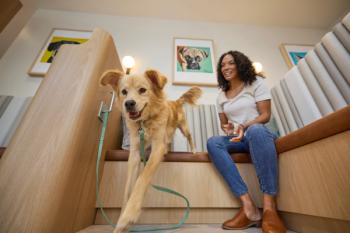
- dvm360 October 2021
- Volume 52
- Issue 10
Benefits of design-build for creating the hospital of your dreams
Three of the most common project delivery methods explained, plus why choosing design-build is the way to go.
In a recent Fetch dvm360® talk, Josh Herrman, AIA, DBIA, and Matt Byrum, AIA, LEED AP, explained that choosing which project delivery method to use is one of the key decisions to make when remodeling or building a hospital, as it affects many aspects of the project. They described it as “the combination of contract types and relationships used to take a new building or remodel from the first idea to final inspection.”
Typical project delivery methods in commercial construction include design-bid-build (DBB), construction management at-risk (CMAR), and design-build (DB). Herrman and Byrum insist that DB is the best approach. Learn about these options, and why Herrman and Byrum prefer DB.
Three most common project delivery methods
Design-bid-build—“a commodity”
Led by an architect or engineer and occurring in 3 unique phases, DBB is a “traditional mainstay in the construction industry,” according to Herrman. The owner has a minimum of 2 contracts: One with the architect/engineer and one with the builder. This is most commonly awarded to “low bidder.” A differentiating factor of this method is that the architect/engineer seeks bids from general contractors (GCs) and those GCs choose the subcontractors they feel are best (usually the lowest bid to the GC). Typically the owner has no say in the subcontractors selected, nor what they really cost. Then the architect/engineer oversees the construction phase.
Construction management at-risk—“a service”
CMAR offers you more control. You still have 2 contracts to manage–1 with the architect and 1 with the builder–but you choose the GC up front, and they act as a partner, said Byrum. The CMAR often provides preconstruction services prior to bids. In addition, the construction manager is “at risk,” as they present a guaranteed maximum price (GMP) and accept the loss if the project goes over budget. Though you have a closer relationship with the GC, you are also banking on both architect and builder to work closely with each other for a successful result.
Design-build—“an experience”
DB involves having only 1 contract because your designers, builders, and anyone else involved with the project all collaborate under 1 contract. This saves time and money, and ensures a highly collaborative, smooth, and stress-free process.
Benefits of design-build
DB is the oldest and fastest-growing delivery method in the United States1 and that is no coincidence, noted Herrman and Byrum. Owners are spreading the word and sharing the benefits of this method, such as some of the ones listed below, with friends and associates.
Clear communication
Herrman and Byrum stressed that though DB is a type of contract, what distinguishes it is the mindset and attitude it generates. The designers and builders communicate effectively to serve your needs, including your budget and schedule. Additionally, DB enables you to make confident decisions and facilitates clear communication regarding results for the intended outcome.
One contract, lower risk
There is value in signing 1 contract for a large investment according to Herrman and Byrum. DB projects often result in fewer changes, fewer claims, and less litigation. DB contracts decrease the risk associated with delegating responsibility to various project partners and provide the GMP assurance of the CMAR delivery method.
Speed of delivery
Research2 cited by Herrman and Byrum demonstrated that projects using DB are completed an average of 61% faster than CMAR and 102% faster than traditional DBB. Instead of separating the project into 3 phases (designing, bidding, and building), DB allows the 3 phases to be intertwined, speeding up the overall project timeline. Herrman and Byrum also mentioned that the days it often takes to communicate between multiple companies are reduced to hours and minutes with DB as all the project leaders are from the same firm.
On-target budget
Oftentimes, architects draw up a whole project unsure if the design is in line with the budget. On bid day, the design cost is often higher than the budget, Herrman and Byrum said.
Contrarily, a design-builder puts your budget first while designing and can work in office with estimators, materials experts, interior designers, and construction managers. DB also offers built-in accountability and built-in checks and balances, according to Herrmann and Byrum. This avoids you being overwhelmed by an architect who comes up with a design that is way over budget for you; thus, you can start the process off with confidence in your budget.
Take-aways
Building or remodeling a hospital is no easy feat but choosing DB as the project delivery method can help simplify the process and allow the hospital of your dreams to come to fruition. As there are various other components to this type of project, Herrmann and Byrum recommended that attendees check out the
References
- Design-build utilization: combined market study. FMI Corporation/Design Build Institute of America. June 2018. Accessed September 10, 2021. https://dbia.org/wp-content/uploads/2018/06/Design-Build-Market-Research-FMI-2018.pdf
- New research shows design-build continues to deliver project most efficiently. Design-Build Done Right blog. November 9, 2018. Accessed September 10, 2021.
https://dbia.org/new-research-shows-design-build-continues-to-deliver-project-most-efficiently/ - dvm360® hospital design toolkit. dvm360®. November 2015. Accessed September 10, 2021.
https://cdn.sanity.io/files/0vv8moc6/dvm360/6dc8f53ced8560e444468993927c66823f0a2dae.pdf
Articles in this issue
about 4 years ago
What makes a cat a healthy pet?about 4 years ago
Reunited in person and it feels so good!about 4 years ago
Dental health test kit aids in preventing common disease in catsover 4 years ago
Pet insurance proves valuable to many clientsover 4 years ago
The Dilemma: Promoting a secure, comfortable workplaceover 4 years ago
Dermatologic cytology 101: Tips for collecting samplesover 4 years ago
10 Things to consider when selling a veterinary practiceover 4 years ago
Canine Osteosarcoma: Teaching an Old Dog New Tricksover 4 years ago
Veterinary cannabis for pain management: The endocannabinoidomeNewsletter
From exam room tips to practice management insights, get trusted veterinary news delivered straight to your inbox—subscribe to dvm360.




